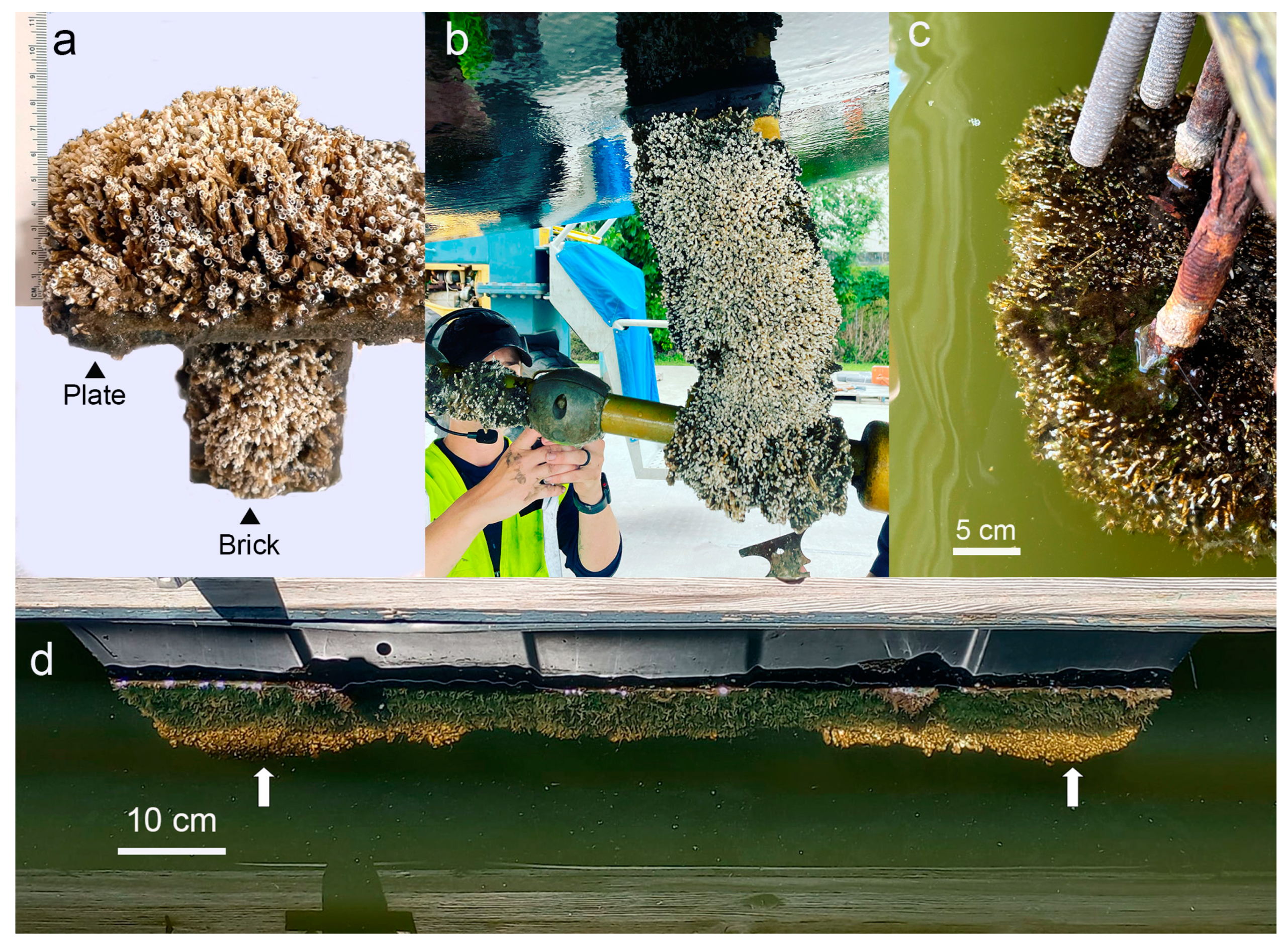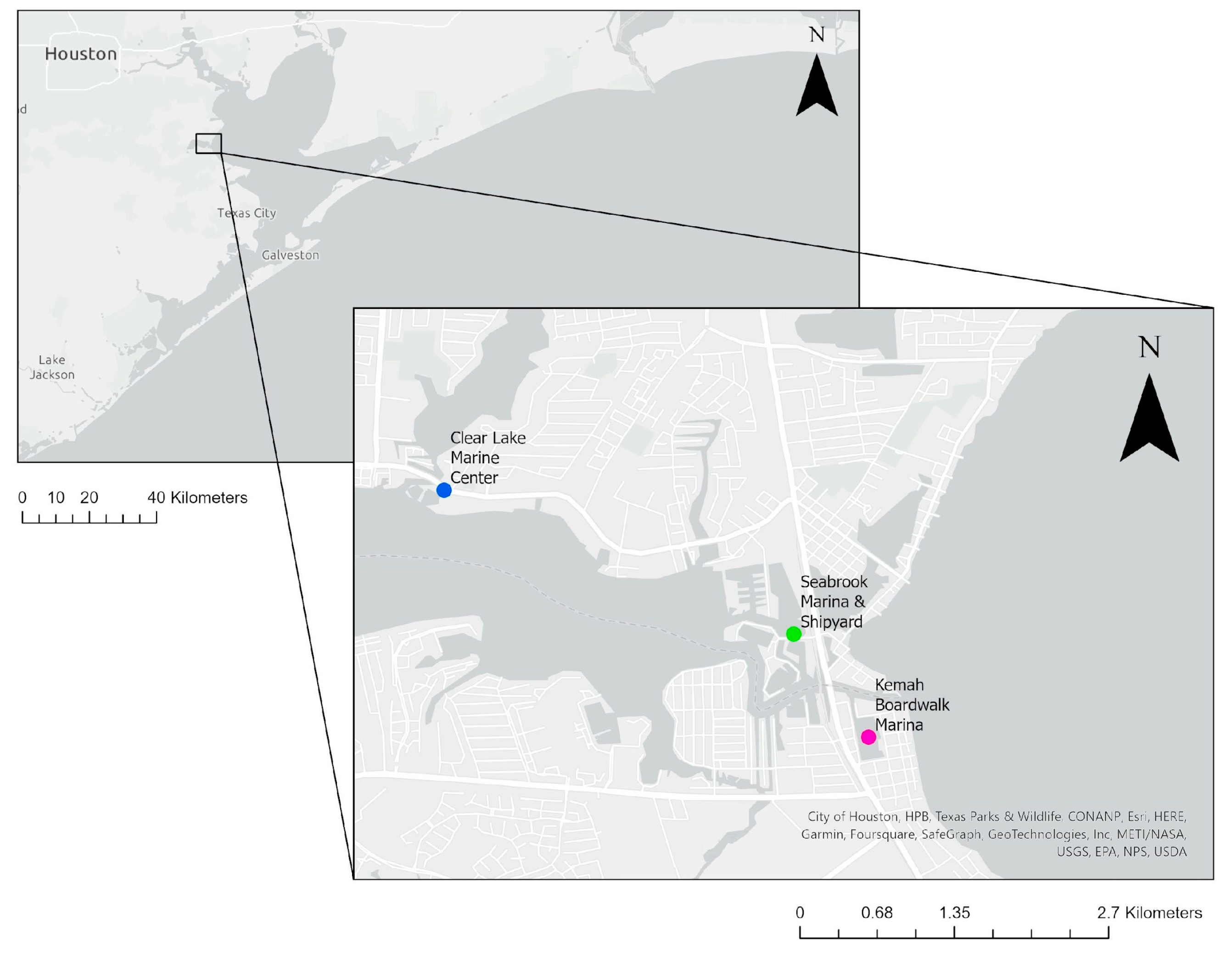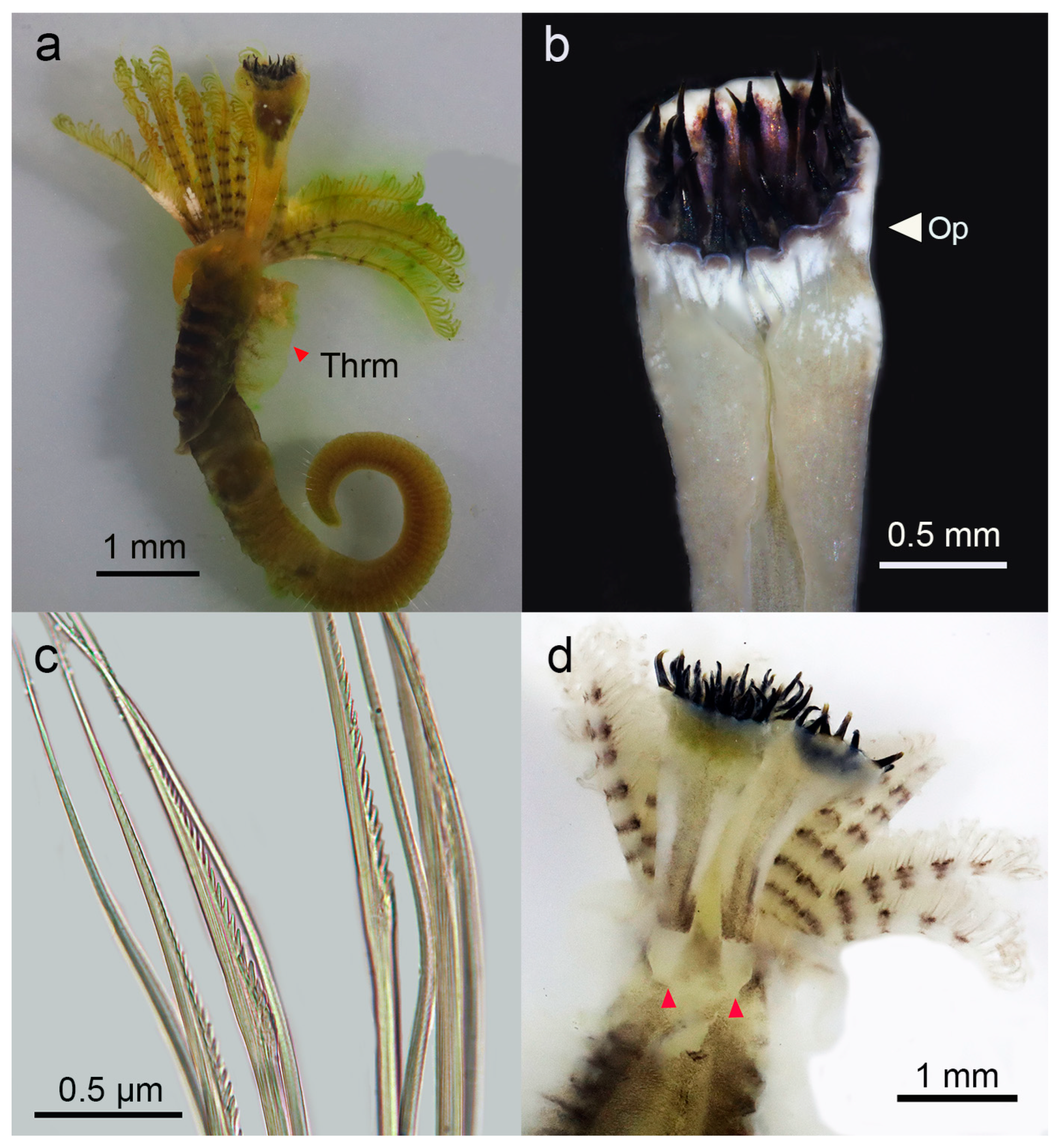Is Ficopomatus enigmaticus (Annelida: Serpulidae) Becoming a Nuisance in Galveston Bay, Texas?
Abstract
Author Contributions
Funding
Data Availability Statement
Acknowledgments
Conflicts of Interest
References
- Williams, S.L.; Grosholz, E.D. The invasive species challenge in estuarine and coastal environments: Marrying management and Science. Estuaries Coasts 2008, 31, 3–20. [Google Scholar] [CrossRef]
- Bailey, S.A.; Brown, L.; Campbell, M.L.; Canning-Clode, J.; Carlton, J.T.; Castro, N.; Chainho, P.; Chan, F.T.; Creed, J.C.; Curd, A.; et al. Trends in the detection of aquatic non-indigenous species across global marine, estuarine and freshwater ecosystems: A 50-year perspective. Divers. Distrib. 2020, 26, 1780–1797. [Google Scholar] [CrossRef]
- Nehring, S. Four arguments why so many alien species settle into estuaries, with special reference to the German river Elbe. Helgol. Mar. Res. 2006, 60, 127–134. [Google Scholar] [CrossRef]
- Steichen, J.L.; Schulze, A.; Brinkmeyer, R.; Quigg, A. All aboard! A biological survey of ballast water onboard vessels spanning the North Atlantic Ocean. Mar. Pollut. Bull. 2014, 87, 201–210. [Google Scholar] [CrossRef]
- Du, J.; Park, K.; Jensen, C.; Dellapenna, T.M.; Zhang, W.G.; Shi, Y. Massive oyster kill in Galveston Bay caused by prolonged low-salinity exposure after Hurricane Harvey. Sci. Total Environ. 2021, 774, 145132. [Google Scholar] [CrossRef]
- Keppel, E. National Exotic Marine and Estuarine Species Information System. Ficopomatis enigmaticus. 2018. Available online: http://invasions.si.edu/nemesis (accessed on 17 June 2023).
- Bastida-Zavala, J.R.; McCann, L.; Keppel, E.; Ruiz, G.M. The fouling serpulids (Polychaeta: Serpulidae) from United States coastal waters: An overview. Eur. J. Taxon. 2017, 344, 1–76. [Google Scholar] [CrossRef]
- Jurgens, L.J.; Ciesielski, M.; Agrawal, A.; Hubbard, E. Low salinity weakens predator effects on community assembly in a sub-tropical estuary. Estuaries Coasts 2022, 45, 2070–2081. [Google Scholar] [CrossRef]
- Hartman, O. Fouling serpulid worms, new to the Gulf of Mexico. Tex. J. Sci. 1952, 4, 63–64. [Google Scholar]
- ten Hove, H.A.; Weerdenburg, J.C.A. A generic revision of the brackish-water serpulid Ficopomatus Southern 1921 (Polychaeta: Serpulinae), including Mercierella Fauvel 1923, Sphaeropomatus Treadwell 1934, Mercierellopsis Rioja 1945 and Neopomatus Pillai 1960. Biol. Bull. 1978, 154, 96–120. [Google Scholar] [CrossRef]
- Kopiy, V.G.; Zaitseva, O.V.; Petrov, S.A. Biological characteristics of the polychaete Ficopomatus enigmaticus (Fauvel, 1923) from mass settlements in the coastal water area of the Kerch Strait (Black Sea). Russ. J. Biol. Invasions 2022, 13, 219–231. [Google Scholar] [CrossRef]
- Schwindt, E.; Bortolus, A.; Iribarne, O.O. Invasion of a reef-builder polychaete: Direct and indirect impacts on the native benthic community structure. Biol. Invasions 2001, 3, 137–149. [Google Scholar] [CrossRef]
- Fornós, J.J.; Forteza, V.; Martínez-Taberner, A. Modern polychaete reefs in Western Mediterranean lagoons: Ficopomatus enigmaticus (Fauvel) in the Albufera of Menorca, Balearic Islands. Palaeogeogr. Palaeoclimatol. Palaeoecol. 1997, 128, 175–186. [Google Scholar] [CrossRef]
- Bastida-Zavala, R.; Sanchez-Ovando, J.P. Serpulidae Rafinesque,1815. In Anélidos Marinos de México y América Tropical, 2nd ed.; de León-González, J.A., Bastida-Zavala, R., Carrera-Parra, L.F., García-Garza, M.E., Sergio Ignacio, S.V., Solís-Weiss, V., Tovar-Hernández, M.A., Eds.; Universidad Autónoma de Nuevo León: Monterrey, Mexico, 2021. [Google Scholar]
- Styan, C.A.; McCluskey, C.F.; Sun, Y.; Kupriyanova, E.K. Cryptic sympatric species across the Australian range of the global estuarine invader Ficopomatus enigmaticus (Fauvel, 1923) (Serpulidae, Annelida). Aquat. Invasions 2017, 12, 53–65. [Google Scholar] [CrossRef]
- Bianchi, C.; Morri, C. The battle is not to the strong: Serpulid reefs in the lagoon of Orbetello (Tuscany, Italy). Estuar. Coast. Shelf Sci. 2001, 53, 215–220. [Google Scholar] [CrossRef]
- Bianchi, C.N.; Morri, C. Ficopomatus ‘Reefs’ in the Po River Delta (Northern Adriatic): Their constructional dynamics, biology, and influences on the brackish-water biota. Mar. Ecol. 1996, 17, 51–56. [Google Scholar] [CrossRef]
- Hille, S.; Kunz, F.; Markfort, G.; Ritzenhofen, L.; Zettler, M.L. First record of mass occurrence of the tubeworm Ficopomatus enigmaticus (Fauvel, 1923) (Serpulidae: Polychaeta) in coastal waters of the Baltic Sea. BioInvasions Rec. 2021, 10, 859–868. [Google Scholar] [CrossRef]
- Pernet, B.; Barton, M.; Fitzhugh, K.; Harris, L.H.; Lizárraga, D.; Ohl, R. Establishment of the reef-forming tubeworm Ficopomatus enigmaticus (Fauvel, 1923) (Annelida: Serpulidae) in southern California. BioInvasions Rec. 2016, 5, 13–19. [Google Scholar] [CrossRef]
- Yee, A.; Mackie, J.; Pernet, B. The distribution and unexpected genetic diversity of the non-indigenous annelid Ficopomatus enigmaticus in California. Aquat. Invasions. 2019, 14, 250–266. [Google Scholar] [CrossRef]
- Schwindt, E.; Iribarne, O.O. Reef of Ficopomatus enigmaticus (Polychaeta; Serpulidae) in the Mar Chiquita coastal lagoon, Argentina. Bolletí Soc. D’història Nat. Balear. 1998, 41, 35–40. [Google Scholar]
- Read, G.B.; Gordon, D.P. Adventive occurrence of the fouling serpulid Ficopomatus enigmaticus (Polychaeta) in New Zealand. N. Z. J. Mar. Freshw. Res. 1991, 25, 269–273. [Google Scholar] [CrossRef]
- Bezuidenhout, M.; Robinson, T.B. Abundance and distribution of the invasive polychaete Ficopomatus enigmaticus in three South African estuaries. Reg. Stud. Mar. Sci. 2020, 39, 101405. [Google Scholar] [CrossRef]
- Bruschetti, M.; Luppi, T.; Fanjul, E.; Rosenthal, A.; Iribarne, O. Grazing effect of the invasive reef-forming polychaete Ficopomatus enigmaticus (Fauvel) on phytoplankton biomass in a SW Atlantic coastal lagoon. J. Exp. Mar. Biol. Ecol. 2008, 354, 212–219. [Google Scholar] [CrossRef]
- Heiman, K.W.; Micheli, F. Non-native ecosystem engineer alters estuarine communities. Integr. Comp. Biol. 2010, 50, 226–236. [Google Scholar] [CrossRef]
- Heiman, K.W.; Vidargas, N.; Micheli, F. Non-native habitat as home for non-native species: Comparison of communities associated with invasive tubeworm and native oyster reefs. Aquat. Biol. 2008, 2, 47–56. [Google Scholar] [CrossRef]
- Martinez, L.E.; Bazterrica, M.C.; Hidalgo, F.J. Influence of complexity and habitat heterogeneity on macrofaunal assemblages provided by an invasive ecosystem engineer in Mar Chiquita coastal lagoon. Estuar. Coast. Shelf Sci. 2020, 246, 107038. [Google Scholar] [CrossRef]
- McQuaid, K.A.; Griffiths, C.L. Alien reef-building polychaete drives long-term changes in invertebrate biomass and diversity in a small, urban estuary. Estuar. Coast. Shelf Sci. 2014, 138, 101–106. [Google Scholar] [CrossRef]
- Dittmann, S.; Rolston, A.; Benger, S.N.; Kupriyanova, E.K. Habitat Requirements, Distribution and Colonisation of the Tubeworm Ficopomatus enigmaticus in the Lower Lakes and Coorong. In Report for the South Australian Murray-Darling Basin Natural Resources Management Board, Adelaide. 2009, p. 99. Available online: https://www.researchgate.net/publication/260981354_Habitat_requirements_distribution_and_colonisation_of_the_tubeworm_Ficopomatus_enigmaticus_in_the_Lower_Lakes_and_Coorong (accessed on 17 June 2023).
- Charles, M.; Faillettaz, R.; Desroy, N.; Fournier, J.; Costil, K. Distribution, associated species and extent of biofouling “reefs” formed by the alien species Ficopomatus enigmaticus (Annelida, Polychaeta) in marinas. Estuar. Coast. Shelf Sci. 2018, 212, 164–175. [Google Scholar] [CrossRef]
- Probert, P.K. First record of the introduced fouling tubeworm Ficopomatus enigmaticus (Polychaeta: Serpulidae) in Hawke Bay, New Zealand. N. Z. J. Zool. 1993, 20, 35–36. [Google Scholar] [CrossRef]



| Marina | Water Temperature (°C) | Salinity (ppt) | Dissolved Oxygen (mg/L) |
|---|---|---|---|
| Kemah Boardwalk Marina | 28.4 | 9.7 | 5.22 |
| Clear Lake Marine Center | 28.4 | 8.1 | 3.61 |
| Seabrook Marina and Shipyard | 28.6 | 10.2 | 5.29 |
Disclaimer/Publisher’s Note: The statements, opinions and data contained in all publications are solely those of the individual author(s) and contributor(s) and not of MDPI and/or the editor(s). MDPI and/or the editor(s) disclaim responsibility for any injury to people or property resulting from any ideas, methods, instructions or products referred to in the content. |
© 2023 by the authors. Licensee MDPI, Basel, Switzerland. This article is an open access article distributed under the terms and conditions of the Creative Commons Attribution (CC BY) license (https://creativecommons.org/licenses/by/4.0/).
Share and Cite
Fernández-Rodríguez, V.; Jurgens, L.; Schulze, A. Is Ficopomatus enigmaticus (Annelida: Serpulidae) Becoming a Nuisance in Galveston Bay, Texas? Diversity 2023, 15, 852. https://doi.org/10.3390/d15070852
Fernández-Rodríguez V, Jurgens L, Schulze A. Is Ficopomatus enigmaticus (Annelida: Serpulidae) Becoming a Nuisance in Galveston Bay, Texas? Diversity. 2023; 15(7):852. https://doi.org/10.3390/d15070852
Chicago/Turabian StyleFernández-Rodríguez, Vanessa, Laura Jurgens, and Anja Schulze. 2023. "Is Ficopomatus enigmaticus (Annelida: Serpulidae) Becoming a Nuisance in Galveston Bay, Texas?" Diversity 15, no. 7: 852. https://doi.org/10.3390/d15070852
APA StyleFernández-Rodríguez, V., Jurgens, L., & Schulze, A. (2023). Is Ficopomatus enigmaticus (Annelida: Serpulidae) Becoming a Nuisance in Galveston Bay, Texas? Diversity, 15(7), 852. https://doi.org/10.3390/d15070852






